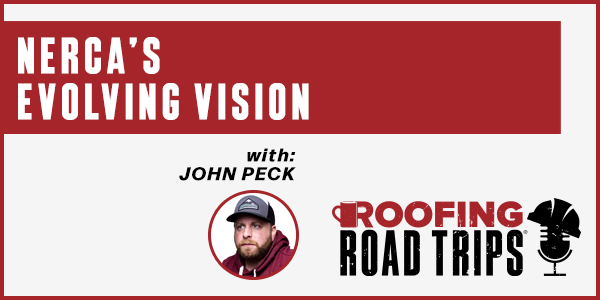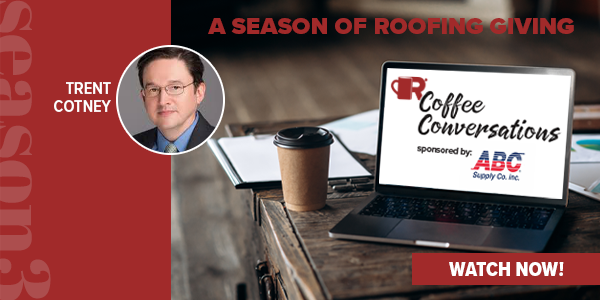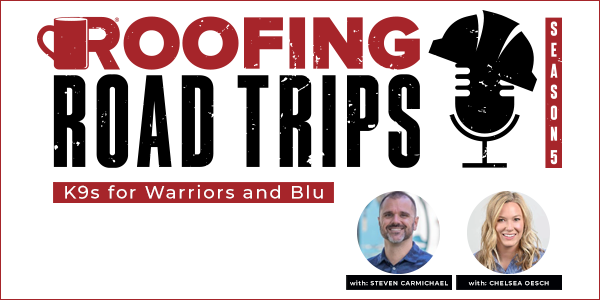Marco Sieber - Fire Protection Starts at the Roof - PODCAST TRANSCRIPTION

Editor's note: The following is the transcript of an live interview with Jennifer Stone and Renae Bales, the co-chairs of National Women in Roofing. You can read the interview below or listen to the podcast.
Announcer:
Welcome to Roofing Road Trips with Heidi. Explore the roofing industry through the eyes of a long-term professional within the trade. Listen for insights, interviews, and exciting news in the roofing industry today.
Heidi Ellsworth:
Hello, and welcome to Roofing Road Trips with RoofersCoffeeShop. My name is Heidi Ellsworth and I am a RoofersCoffeeShop partner, so excited to be here today. Our podcast today is all about fire. And for many of you, you may know, I live in the Pacific Northwest. We have had tremendous, terrible wildfires over the last couple of years, obviously through California. I've been to Oregon and Washington and all over. And so, today's podcast is, to me, really going to share something that could make a serious difference in not only saving buildings, but saving lives.
So today, I would love to introduce and welcome Marco Sieber from Polyglass. He's the national product manager. And he is going to share with us the innovations that Polyglass has going on with fire protection. Marco, welcome to the show.
Marco Sieber:
Hi, Heidi. Thanks for having me. I'm glad to be able to present to you and your audience.
Heidi Ellsworth:
Well, I am happy to have you here. Polyglass is near and dear to my heart, having worked with you all off and on over the years. But really, before we kind of get into the innovation of Polyglass, which is so... I mean, I love this stuff. I love what you're doing over there. Can you introduce yourself a little bit more and kind of what you do at Polyglass?
Marco Sieber:
Sure. I'm the national product manager here. And we have several project managers within Polyglass. I happen to manage our largest business segment, which is the membranes portion of our business. So, I manage both steep slope and low slope membranes for roofing. And so, basically, as the product manager, I'm responsible for leading our business strategy, design knowledge, and, and just finding what our customer needs are, in the marketplace, in order to develop and maintain products that are kind of relevant and valuable to the marketplace throughout their life cycle.
Heidi Ellsworth:
And that's been going on for a long time. You all really listen to the contractors and the customers on what they need. I would love it, Marco, if you would share with the audience just a little bit of the history of Polyglass. And I know it actually started outside the U S. And so, maybe you can share just a little bit of that overall for those who don't know that.
Marco Sieber:
Sure. Polyglass was founded... It was a family run business founded by the Zanchetta family. And actually, we still have a member of that family as our CEO today, Natalino Zanchetta. And in Italy, Polyglass became a leading manufacturer of modified bitumen roofing membranes back in the sixties. And then, part of the family moved... including Natalino, moved to the United States in the early nineties to try to kind of expand the business outside of Europe. And that was, I think, around 1992.
And at that point, Polyglass, both in Europe and the United States, started launching quite a few of these innovative technologies they had not been seen in the United States before, including our self adhered ADESO technology, which I think I'll talk about a little bit later. That was in the nineties. And it positioned Polyglass as a leader in self [inaudible 00:03:57] modified bitumen membranes. And in fact, one of the products that I think we're going to talk about today here incorporates ADESO technology, which we've had for a long time, as well as a new patent pending technology called Burn-Shield shield.
Heidi Ellsworth:
Yes. That is really... As we started this out, that is really the heart of this podcast. And I'm so excited about that. So, before we get to the fire, just to give one more kind of review of the Polystick products... And I think you and I shared this beforehand, but I was really lucky to work with Polyglass for many years on marketing and promoting.
And the Polystick product was always the one that was just like one innovation after another. Can you share a little bit about that line for steep slope roofing, and really how it's solving the problems for roofers and for building owners?
Marco Sieber:
Yeah. Polyglass offers a full line of roofing underlayments. And that's basically kind of what we're talking about today with the Polystick XFR, the fire resistant underlayment. But we have a pretty large line of underlayments. And I'm sure your audience knows that underlayments are an integral part of a steep slope roofing system. They're a secondary... a waterproofing layer that's installed on the roof decking, which is usually wood, and below your roof covering. Your roof covering can be shingle, metal, tile. There are a lot of roof covering types. So, Polystick just happens to be the branding that we use to refer to our line of steep slope roofing underlayments. And these products can be used on residential applications, as well as steep slope commercial buildings. They're used very extensively there.
And all of our Polystick underlayments, that's why they call it Polystick because they do have that self adhered ADESO technology. All of them have that in common. But the ADESO technology is very unique in that it really differentiates, in the product, that top portion is used as a dedicated layer that's going to take the brunt of the forces of the roof covering and their environmental factors, the sun and the rain, everything that beats on the top of that underlayment over time. And then, the top bottom layer is a dedicated self adhesive layer, that's very aggressive. So, you have those two distinct layers in the product that make that ADESO technology unique. And that's why it's a patented technology, because of the manufacturing process that we use on all of the Polystick products. And basically, the only thing else I'd like to say about Polystick is that we have... Let me see here now. We've got one, two, three, four... We've got about eight underlayments now.
And they're differentiated mainly... are segmented into groups depending on the roof covering type that's used with the underlayment. So, you have underlayments that are dedicated for metal use, metal roof coverings like standing seam metal. Other underlayments are more your ice and water type underlayments, made to work with asphalt shingles, for example. And then, we have a whole other group of products like our Polystick TU Max, TU Plus, that are really mostly used under clay or concrete tile. So, we have... And then, we have some that are hybrids that can be used for several roof covering types. But that's kind of how we have those products segmented.
Heidi Ellsworth:
And so, it really saw... I mean, as a roofing contractor, no matter what you're putting on, you're going to be able to find a Polystick product that's going to fit the needs of that, the tiles, or the metal, or the shingles.
Marco Sieber:
Correct. I can't think of any roof covering type that we don't have you covered with.
Heidi Ellsworth:
And that makes it so nice for contractors to know that they are being able to offer that protection, that quality, with any type of roofing system. But the thing to... I know you've always had high temp. I mean, your high temp products, or Polystick, is great under metal. But let's talk a little bit about this next step with the X F R and the fire resistance. With what's happening with our wildfires and the crazy weather across the country, talk about the perfect time. How did this product come about?
Marco Sieber:
Well, it's been about... It took about two years really to develop, until we actually launched the product. I think it was second quarter of last year. So, we kind of had a soft launch. We just saw... and not just in the wildfire areas, but other municipalities across the country, including here where I live here in south Florida. There is a need, either because the building codes in those areas mandate it, or because it brings peace of mind to the homeowner or the building owner in terms of fire resistance for their building. And that could be fire resistance because of wildfires, like we saw... we've been seeing over the past several years out west, including California, and you were talking about Pacific Northwest. Also Colorado is another area where we have a lot of issues with wildfires. But there are other parts of country where they just mandate it for different reasons that a building needs to meet a certain fire classification.
And in the case of these different parts in California that I'm talking about, and in south Florida, they need to meet a class A fire rating. So, what... Polystick XFR was designed around that need, that we just kept on getting feedback from building owners and architects as well, people who design these buildings, and contractors that the alternatives out there for getting this fire resistance for your roofing system required multiple layers in many cases, and didn't really offer water proofing and fire protection at the same time.
And Polystick XFR does offer both of these things, fire protection and water protection, and with a single layer product, where you don't have to install multiple layers of other products, like some of our competitors.
Heidi Ellsworth:
And just in my mind, I'm thinking, how does that work? How are you doing that? I know you have patent pending on Burn Shield technology that's really kind of making all this possible. So, can you tell us a little bit of, what's the makeup of the underlayment and why is it so effective?
Marco Sieber:
Well, what you have is... And maybe I take a step back and then I'd come back to that question, because it's related. Because a lot of people think like, "Well, what does the roof have to do with fire protection?"
Heidi Ellsworth:
Yeah.
Marco Sieber:
You know? So, what they've found is, in wildfire areas, but also urban areas where there's a lot of buildings that are very close to one another, when you have a fire, be it because of trees burning, or because of the building next door to you is burning, you have embers that come off of that, that building. That burning building will release embers that are blown by wind onto your roof. And then, your roof catches fire. So, that's what this is all about. And there are tests that are out there, the most common, which is a UL seven 90 UL, is... Underwriters laboratories is a very well-known lab that tests this. And we tested through them. So, that's basically what happens, and why it's very important for the roof to protect the building from these burning flying embers that can really start catching fire.
It's kind of the domino effect. It can actually go throughout a neighborhood, and one building catches fire and just leads to another one catching fire. So, the Polystick XFR, we started trying to find different elements, different components, that we could add to our compound and the makeup of our underlayments. So, we kind of have the same standard construction of our other metal underlayments like Polystick MTS plus. But we have added certain proprietary elements to the compound that, when an Ember, for example, falls on the surface of the membrane or the whatever the roof covering is, and starts burning and transmitting heat, it will hit that, our underlayment, the Polystick XFR, in a way to actually create kind of a shield.
Because it will... Instead of burning, like in a flame, it'll char. So, it actually kind of creates a crust, I guess you could say. It chars the surface. And it starts kind of expanding. And it creates... When you look at it, it creates a shield. And that's why we called it Burn Shield technology. So, the Burn Shield technology has to do with the components that are placed in the product itself, and how it's applied onto the product in our production lines. And that's what forms our patent for the product.
Heidi Ellsworth:
That is cool. That is cool. So, using its own properties to create that shield, to create that protection. And I've seen it time after time, as these embers are flying. And that's what exactly what... In fact, I saw houses around... over on... in the west side of Oregon, after the fires, the thing where you'd have a house burnt, and then a house standing, and then, right next to that, a house burnt.
And so that you can see it's totally embers going to the different parts of the roof. So, being able to have the roof kind of automatically start protecting itself, underneath the shingles or underneath the tile wood, however it gets there, that's brilliant.
Marco Sieber:
Yeah. That's what that... That's right. And that's just one element of fiber resistance in a building. Of course, you'd have the sides of the building and your perimeter around the building, like your landscape and everything. But the roof is a very important element of that. So, it's really nice to see that we're offering some protection to the building owners through this product.
Heidi Ellsworth:
Exactly what we need right now, exactly what we need. And how is the product testing and building code approvals? Where are you with the product on all of those?
Marco Sieber:
We've done extensive testing with the product. We test it internally in our labs, and then we take it to a third party lab. And we kind of pretest it before we take it to UL to actually do the final testing, to get the UL classification for the product. So, the product is UL classified. And the product also helps achieve a UL class A fire rating, which is the highest standard available underneath a metal roof covering. So, you can get a UL class A fire rating under a clay or concrete tile. You can get it under metal. And you can also get it under a class A asphalt shingles, which is kind of... It transfers over the class A fire classification to those three different roof covering times. And we are also testing some additional roof covering types to try to get that placed a class A fire rating as well, such as under aluminum roofing, synthetic shake.
So, there's still some work to be done. And that's kind of ongoing testing, and it all kinds of takes time. But we also have something that's interesting that we obtained. Throughout UL classification, we presented evidence of the fire resistance the product provides. And we got listed by the California state fire Marshall. So, they actually have a listing on their website of products that kind of have been certified by them, or listed to meet a certain fire classifications for wildlife urban interface areas in California, where you have these areas of where you have a lot of wildfires. So, we are in their listing. We also have a listing with ICC, a Florida building code, recently with Miami-Dade building code, and also Texas department of insurance.
Heidi Ellsworth:
Wow. That's impressive. And to get onto the fire marshals in California, that's huge. That is... Congratulations. That is quite the accomplishment. And it brings about a lot of trust for those building owners and homeowners out there. So Marco, I always like to kind of bring it back. How can roofing contractors really kind of take all this testing, obviously your product, your literature, and how can they use that to help in the sale with their homeowners, talking about this fire thing? What kind of tools do you have for them to help them kind of start including this in their... on all the re roofing they're doing after these fires in these areas, but also overall in fire prone areas?
Marco Sieber:
Yeah. I think that... And what we're seeing out west... And we're very successful since the launch, especially out west, and now it's starting in other parts of the country. I think contractors find it as a great opportunity to go out there and really sell this to the building owner as something that provides, in a single product, their water proofing needs. So, it's going to give you that secondary water barrier protection and that fire resistance, be it because the local code mandates it, or just to give you the peace of mind, to know that your property and the livelihood of the people that either live there or operate within the building are safe.
I think that's a great selling tool. And then, the contractors have really the added incentive of the fact that they're using a single layer instead of multiple layers. And that's really where the contractors benefit from a product like this, where they're saving on labor and material costs. So, you're just going with one layer system, and you just don't need anything else other than that in order to meet that fire classification. So, I think it has several benefits, both for the contractor and also for the building owner that the contractor can use as a sales tool to get the customers on board with using a product like this.
Heidi Ellsworth:
That makes so much sense, because you're right. With the multiple layers, to get a class A fire rating, you have a lot more cost into it. Now, all of a sudden, contractors are able to go to the homeowners or to the building owners, and show them a really great protection at less cost. How often does that happen?
Marco Sieber:
Not very often.
Heidi Ellsworth:
Not very often. I think that's great. Well, I can definitely see... And I know, with the building codes, just finding out if you're in a class A fire rated area, and even for contractors who maybe are listening to this who think, "Oh. I'm not in class A", you'd be surprised. So, definitely check your urban areas, check where you're at, because you don't want to be putting on roofs that are not class A rated in where it's required by building code, and really, honestly, anywhere where there's tendencies towards fire.
Marco Sieber:
Yeah, that's right.
Heidi Ellsworth:
Okay. Let's talk a little bit about how Polyglass, how contractors, can get this XFR. Where is it? How's the best way for them to start buying it and to start incorporating it into their business?
Marco Sieber:
Well, there's a growing number of roofing distributors who we work with, with our other products, that are currently carrying Polystick XFR. So, contractors already might... They might want to start asking for it. I mean, that would be the great, great thing for us, for contractors to demand from the roofing distributors that they usually go to, that if they're not carrying this product to start carrying it, because they see the potential in it.
In addition to that, they can always contact their Polyglass sales rep to find how they can start using the product and where they can locate it. And there's a link on our website. I think that would probably be the easiest way. We have several emails where you can kind of contact us directly. But if you go on our website, there is a tool there that's called a sales rep locator. And they can go and put in their zip code, and it'll bring up phone number and email of... and name of their local Polyglass sales rep.
Heidi Ellsworth:
And I know a lot of Polyglass sales reps. And they are just... They are just quality, quality sales reps who can really help contractors to take not only the XFR product, but all the Polystick products, and figure out the best applications. They're very knowledgeable. I highly recommend spending some time, not just on where to buy it, but also just to get the knowledge, to understand the products and the innovations, and be able to apply those within your business to be able to sell more, and sell higher quality, more profitable roofing systems.
Marco Sieber:
Yeah. That's right. And we've done a lot of educating of our sales force pre launch of this product. So, I think that, like you said, they're going to be very... They have more information probably than I provided today here for your particular needs or the contractor's particular needs. They'll be able to provide that support.
Heidi Ellsworth:
I love it. And just as always, just so everyone knows, Polyglass is on RoofersCoffeeShop. They have a full directory. In that directory, you can get to the website that Marco's talking about. You can get to the rep locator. And you can also get some great information. Marco, you and your team have just done such a great job on the literature, on helping in that sale, in really helping to explain how it can help on both the contractor's business, and in the homeowners, to be able to give them something to give them a sense of peace, and a sense of trust of knowing their house is going to be better protected. So, thank you. Thank you so much for sharing this information. And thank you, as a product manager, for leading these innovations with such a great company. It brings so much value and professionalism to the roofing industry.
Marco Sieber:
I appreciate it. Yeah. We're actually looking for different ways in which to use the Burn Shield technology and other products, to continue providing these products, which are valuable, for the safety of the homeowners.
Heidi Ellsworth:
I love it. I love it. So, stay tuned is what I'm hearing. There's more to come. I love it. Well, thank you Marco again so much for being here today. And I want to say thank you to everyone listening to this podcast. As I said, all of this information is on RoofersCoffeeShop, in the Polyglass directory, and also in their many articles.
You're also going to be able to find several podcasts and webinars on different innovations, different products, different trends and initiatives, all on the podcast page, under the read, listen, watch section of RoofersCoffeeShop. We provide it so you can watch it, listen to it, or read it anytime that's good for you. So, thank you so much for being here today. Have a great time. And we'll see you next time on Roofing Road Trips.
Announcer:
Make sure to subscribe to our channel and leave a review. Thanks for listening. This has been Roofing Road Trips with Heidi from the rooferscoffeeshop.com.






















Comments
Leave a Reply
Have an account? Login to leave a comment!
Sign In